Renewable Energy Tracking and Optimization in a Hybrid Electric Vehicle Charging Station
Abstract
:Featured Application
Abstract
1. Introduction
- (a)
- Voltage dips during periods of EV charging (particularly for fast chargers);
- (b)
- Reduction in power quality (both slow and fast charging stations are sources of harmonic distortion);
- (c)
- EV battery deterioration and capacity decrease (due to the battery’s voltage level or temperature increase);
- (d)
- Overloading of distribution network transformers;
- (e)
- Increased energy losses (especially with larger direct current (DC) fast charging station penetration)
- the simultaneous optimization of charging/discharging BES and EV charging power;
- the implementation of energy tracking methodology that monitors the origin of energy from and to the battery;
- the multiobjective optimization of different conflicting criteria.
2. Energy Tracking Methodology
2.1. Energy Tracking during Battery Charge/Discharge
2.2. Energy Tracking during EV Charging
2.3. Battery Degradation Model
3. Optimization Problem
- ui(xi) = the single-attribute utility value for attribute i with value xi (ranges from 0 to 1);
- ki = a parameter from the tradeoffs for component i;
- K = a normalization constant.
4. Results
5. Discussion
6. Conclusions
Author Contributions
Funding
Data Availability Statement
Conflicts of Interest
Nomenclature
| SOCt | Battery state of charge at time t |
| SOCS,t | Solar energy share state of charge at time t |
| SOCG,t | Public grid energy share state of charge at time t |
| C | Battery capacity (kWh) |
| kc/d | Charging/discharging efficiency |
| PB,t | Battery power at time t (kW) |
| PBS, | Battery power originating from solar energy at time t (kW) |
| PBG,t | Battery power originating from the public grid at time t (kW) |
| PEV,t | Electric vehicle charging power at time t (kW) |
| PEVS,t | Electric vehicle charging power originating from solar energy at time t (kW) |
| PEVG,t | Electric vehicle charging power originating from the public grid at time t (kW) |
| PEVBS,t | Electric vehicle charging power originating from the solar battery share at time t (kW) |
| PEVBG,t | Electric vehicle charging power originating from the grid battery share at time t (kW) |
| PS,i,t; QS,i,t | Solar PV plant power at node i, at time t (kW) |
| PB,i,t; QB,i,t | Battery power at node i, at time t (kW) |
| PL,i,t; QL,i,t | Load demand at node i, at time t (kW) |
| PG,i,t; QG,i,t | Public grid power at node i, at time t (kW) |
| PEV,i,t; QEV,i,t | EV charging power at node i, at time t (kW) |
| Pbi,j; Qbi,j | Power flow in branch b from node i to j |
| Vi, θi | Voltage magnitude and angle at the node i |
| Gij, Bij | Branch conductance and susceptance from node i to j |
| φb | Total set of branches |
| Ah | Energy flow in ampere-hours |
| Qloss | Battery degradation (%) |
| Irate | Battery charge/discharge rate expressed in capacity ratio C |
| ct | Spot energy price at time t (€/kWh) |
| cB | Levelized daily battery installation and operation costs (€/kWh∙day) |
| Ures | Renewable energy share utility function |
| Utc | Total costs utility function |
| Ubd | Battery degradation utility function |
References
- Larminie, J.; Lowry, J. Electric Vehicle Technology Explained; Wiley: New York, NY, USA, 2003. [Google Scholar]
- Ehsani, M.; Gao, Y.; Gay, S.E.; Emadi, A. Modern Electric, Hybrid Electric and Fuel Cell Vehicles; CRC Press: Boca Raton, FL, USA, 2005. [Google Scholar]
- Wirasingha, S.G.; Pihef, A.E. Plug-in hybrid electric factor. IEEE Trans. Veh. Technol. 2011, 60, 1279–1284. [Google Scholar] [CrossRef]
- Nichoals, M.; Hall, D. Lessons Learned on Early Electric Vehicle Fast-charging Deployments, White Paper for the International Council on Clean Transportation. 2018. Available online: https://www.theicct.org/sites/default/files/publications/ZEV_fast_charging_white_paper_final.pdf (accessed on 29 March 2020).
- Bhatti, A.R.; Salam, Z.; Aziz, M.J.B.A.; Yee, K.P.; Ashique, R.H. Electric vehicles charging using photovoltaic: Status and technological review. Renew. Sustain. Energy Rev. 2016, 54, 34–47. [Google Scholar] [CrossRef]
- Kawamura, N.; Muta, M. Development of solar charging system for plug-in hybrid electric vehicles and electric vehicles. In Proceedings of the 2012 International Conference on Renewable Energy Research and Applications (ICRERA), Nagasaki, Japan, 11–14 November 2012; IEEE: Nagasaki, Japan, 2012; pp. 1–5. [Google Scholar]
- Mesentean, S.; Feucht, W.; Kula, H.-G.; Frank, H. Smart charging of electric scooters for home to work and home to education transports from grid connected photovoltaic-systems. In Proceedings of the 2010 IEEE International Energy Conference, Manama, Bahrain, 18–22 December 2010; IEEE: Manama, Bahrain, 2010; pp. 73–78. [Google Scholar]
- Gurkaynak, Y.; Khaligh, A. Control and Power Management of a Grid Connected Residential Photovoltaic System with Plug-in Hybrid Electric Vehicle (PHEV) Load. In Proceedings of the 2009 Twenty-Fourth Annual IEEE Applied Power Electronics Conference and Exposition, Washington, DC, USA, 15–19 February 2009; IEEE: Washington, DC, USA, 2009; pp. 2086–2091. [Google Scholar]
- Gurkaynak, Y.; Li, Z.; Khaligh, A. A novel grid-tied, solar powered residential home with plug-in hybrid electric vehicle (PHEV) loads. In Proceedings of the 2009 IEEE Vehicle Power and Propulsion Conference, Dearborn, MI, USA, 7–11 September 2009; IEEE: Dearborn, MI, USA, 2009; pp. 813–816. [Google Scholar]
- Robalino, D.M.; Kumar, G.; Uzoechi, L.O.; Chukwu, U.C.; Mahajan, S.M. Design of a docking station for solar charged electric and fuel cell vehicles. In Proceedings of the 2009 International Conference on Clean Electrical Power, Capri, Italy, 9–11 June 2009; IEEE: Capri, Italy, 2009; pp. 655–660. [Google Scholar]
- Sujitha, N.; Krithiga, S. RES based EV battery charging system: A review. Renew. Sustain. Energy Rev. 2017, 75, 978–988. [Google Scholar] [CrossRef]
- Tesfaye, M.; Castello, C.C. Minimization of impact from electric vehicle supply equipment to the electric grid using a dynamically controlled battery bank for peak load shaving. In Proceedings of the 2013 IEEE PES Innovative Smart Grid Technologies Conference (ISGT), Washington, DC, USA, 24–27 February 2013; IEEE: Washington, DC, USA, 2013; pp. 1–6. [Google Scholar]
- Castello, C.C.; LaClair, T.J.; Maxey, L.C. Control strategies for electric vehicle (EV) charging using renewables and local storage. In Proceedings of the 2014 IEEE Transportation Electrification Conference and Expo (ITEC), Dearborn, MI, USA, 15–18 June 2014; IEEE: Dearborn, MI, USA, 2014; pp. 1–7. [Google Scholar]
- Mouli, G.C.; Bauer, P.; Zeman, M. System design for a solar powered electric vehicle charging station for workplaces. Appl. Energy 2016, 168, 434–443. [Google Scholar] [CrossRef] [Green Version]
- García-Triviño, P.; Torreglosa, J.P.; Fernández-Ramírez, L.M.; Jurado, F. Control and operation of power sources in a medium-voltage direct-current microgrid for an electric vehicle fast charging station with a photovoltaic and a battery energy storage system. Energy 2016, 115, 38–48. [Google Scholar] [CrossRef]
- Janjic, A.; Velimirovic, L. Optimal Scheduling of Utility Electric Vehicle Fleet Offering Ancillary Services. ETRI J. 2015, 37, 273–282. [Google Scholar] [CrossRef]
- Janjic, A.; Velimirovic, L.; Stankovic, M.; Petrusic, L. Commercial electric vehicle fleet scheduling for secondary frequency control. Electr. Power Syst. Res. 2017, 147, 31–41. [Google Scholar] [CrossRef]
- Mossoba, J.; Kromer, M.; Faill, P.; Katz, S.; Borowy, B.; Nichols, S.; Casey, L.; Maksimovic, D.; Traube, J.; Lu, F. Analysis of solar irradiance intermittency mitigation using constant DC voltage PV and EV battery storage. In Proceedings of the 2012 IEEE Transportation Electrification Conference and Expo (ITEC), Dearborn, MI, USA, 18–20 June 2012; IEEE: Dearborn, MI, USA, 2012; pp. 1–6. [Google Scholar]
- Chaudhari, K.; Ukil, A.; Kumar, K.N.; Manandhar, U.; Kollimalla, S.K. Hybrid Optimization for Economic Deployment of ESS in PV-Integrated EV Charging Stations. IEEE Trans. Ind. Inform. 2018, 14, 106–116. [Google Scholar] [CrossRef]
- Bhatti, A.R.; Salam, Z.; Sultana, B.; Rasheed, N.; Awan, A.B.; Sultana, U.; Younas, M. Optimized sizing of photovoltaic grid-connected electric vehicle charging system using particle swarm optimization. Int. J. Energy Res. 2019, 43, 500–522. [Google Scholar] [CrossRef]
- Tang, W.; Zhang, Y.J.A. A Model Predictive Control Approach for Low-Complexity Electric Vehicle Charging Scheduling: Optimality and Scalability. IEEE Trans. Power Syst. 2017, 32, 1050–1063. [Google Scholar] [CrossRef] [Green Version]
- Domínguez-Navarro, J.A.; Dufo-López, R.; Yusta, J.; Artal-Sevil, J.; Bernal-Agustín, J.L. Design of an electric vehicle fast-charging station with integration of renewable energy and storage systems. Int. J. Electr. Power Energy Syst. 2019, 105, 46–58. [Google Scholar] [CrossRef]
- Badea, G.; Felseghi, R.; Varlam, M.; Filote, C.; Culcer, M.; Iliescu, M.; Raboaca, M.S. Design and Simulation of Romanian Solar Energy Charging Station for Electric Vehicles. Energies 2018, 12, 74. [Google Scholar] [CrossRef] [Green Version]
- Zhang, M.; Chen, J. The Energy Management and Optimized Operation of Electric Vehicles Based on Microgrid. IEEE Trans. Power Deliv. 2014, 29, 1427–1435. [Google Scholar] [CrossRef]
- Xu, Q.; Zhang, N.; Kang, C.; Wang, R.; Wang, J.; Cui, Z.; Yang, Z. Day-ahead battery scheduling in microgrid considering wind power uncertainty using ordinal optimization. In Proceedings of the 2014 North American Power Symposium (NAPS), Pullman, WA, USA, 7−9 September 2014; pp. 1–6. [Google Scholar]
- Hafez, O.; Bhattacharya, K. Optimal design of electric vehicle charging stations considering various energy resources. Renew. Energy 2017, 107, 576–589. [Google Scholar] [CrossRef]
- Baik, S.H.; Jin, Y.G.; Yoon, Y.T. Determining Equipment Capacity of Electric Vehicle Charging Station Operator for Profit Maximization. Energies 2018, 11, 2301. [Google Scholar] [CrossRef] [Green Version]
- Torreglosa, J.P.; García-Triviño, P.; Fernández-Ramirez, L.M.; Jurado, F. Decentralized energy management strategy based on predictive controllers for a medium voltage direct current photovoltaic electric vehicle charging station. Energy Convers. Manag. 2016, 108, 1–13. [Google Scholar] [CrossRef]
- Yao, L.; Damiran, Z.; Lim, W.H. Optimal Charging and Discharging Scheduling for Electric Vehicles in a Parking Station with Photovoltaic System and Energy Storage System. Energies 2017, 10, 550. [Google Scholar] [CrossRef]
- Dai, Q.; Liu, J.; Wei, Q. Optimal Photovoltaic/Battery Energy Storage/Electric Vehicle Charging Station Design Based on Multi-Agent Particle Swarm Optimization Algorithm. Sustainability 2019, 11, 1973. [Google Scholar] [CrossRef] [Green Version]
- Hassoune, A.; Khafallah, M.; Mesbahi, A.; Bouragba, T. Power Management Strategies of Electric Vehicle Charging Station Based Grid Tied PV-Battery System. Int. J. Renew. Energy Res. 2018, 8, 1–10. [Google Scholar]
- Wi, Y.-M.; Lee, J.-U.; Joo, S.-K. Electric vehicle charging method for smart homes/buildings with a photovoltaic system. IEEE Trans.Consum. Electron. 2013, 59, 323–328. [Google Scholar] [CrossRef]
- Yan, Q.; Zhang, B.; Kezunovic, M. Optimized Operational Cost Reduction for an EV Charging Station Integrated With Battery Energy Storage and PV Generation. IEEE Trans. Smart Grid 2019, 10, 2096–2106. [Google Scholar] [CrossRef]
- Wang, J.; Purewal, J.; Liu, P.; Hicks-Garner, J.; Soukazian, S.; Sherman, E.; Sorenson, A.; Vu, L.; Tataria, H.; Verbrugge, M.W. Degradation of lithium ion batteries employing graphite negatives and nickel–cobalt–manganese oxide + spinel manganese oxide positives: Part 1, aging mechanisms and life estimation. J. Power Sources 2014, 269, 937–948. [Google Scholar] [CrossRef]

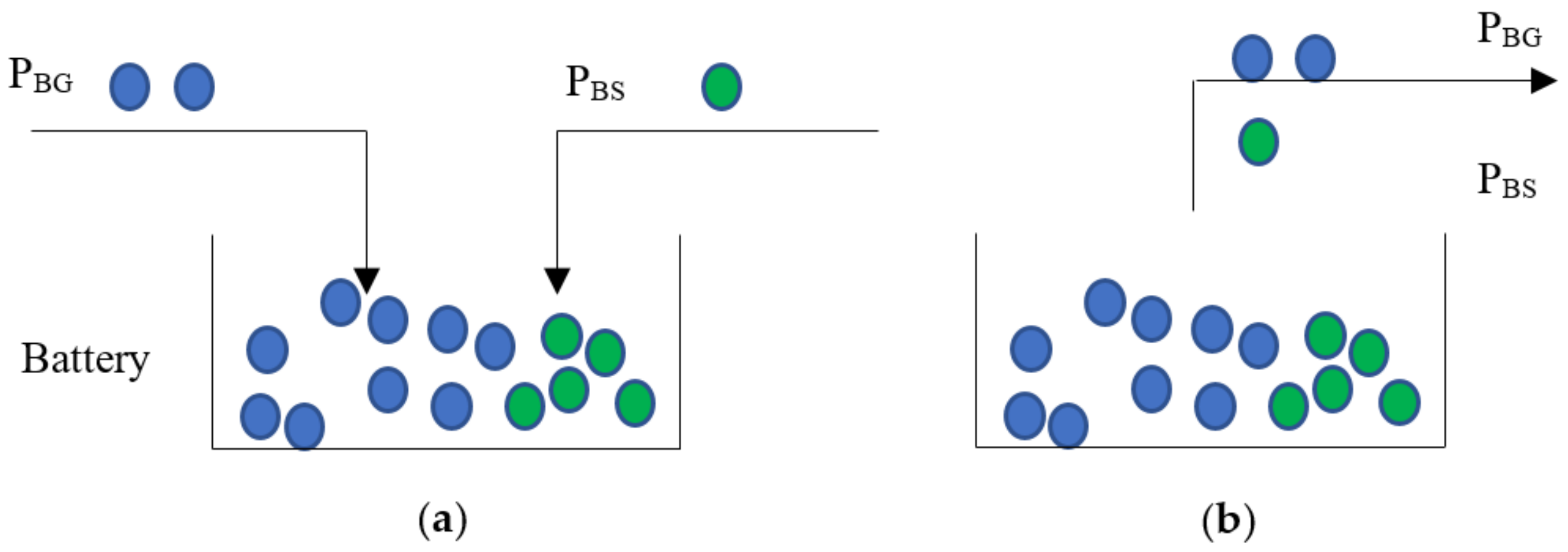
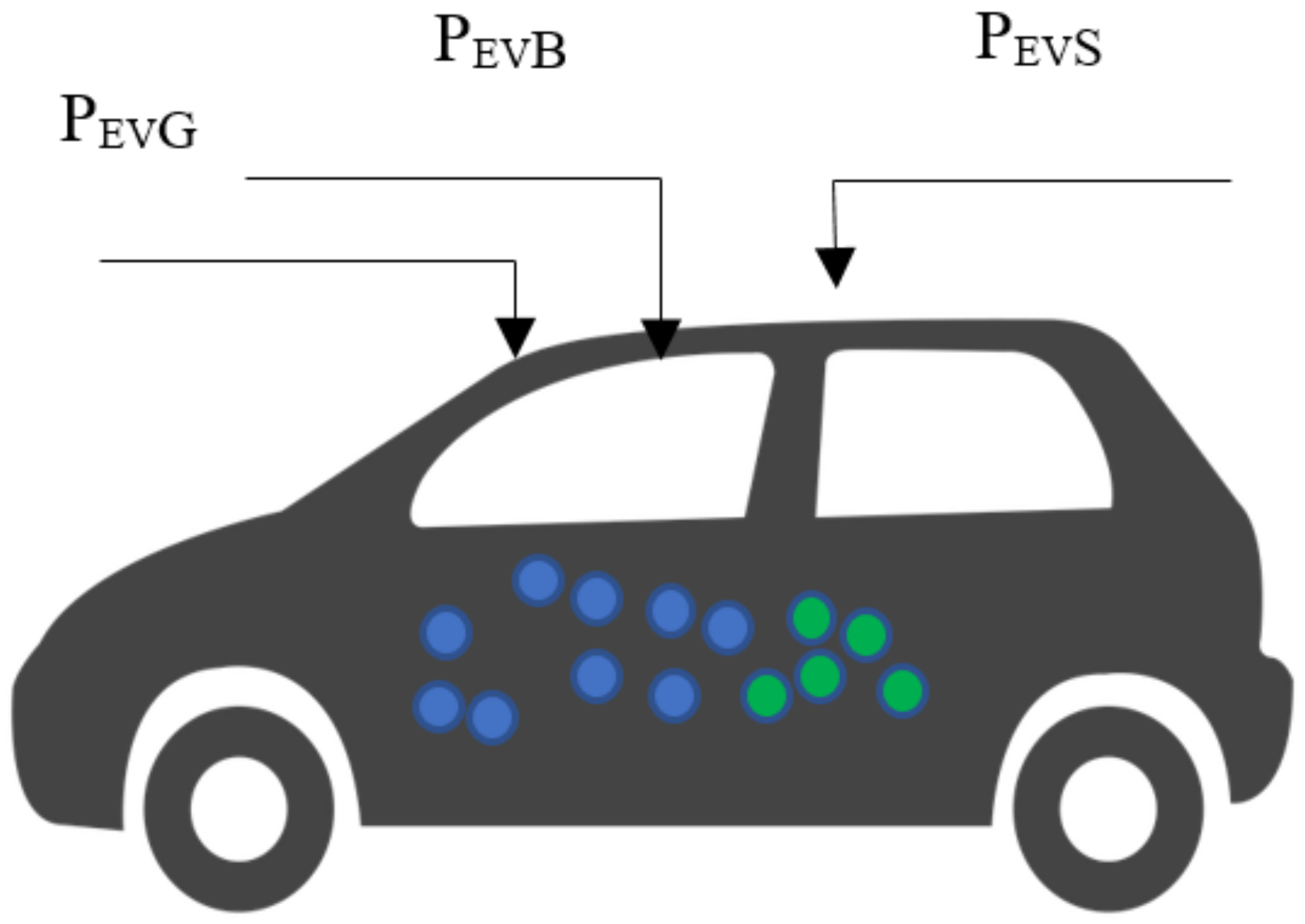
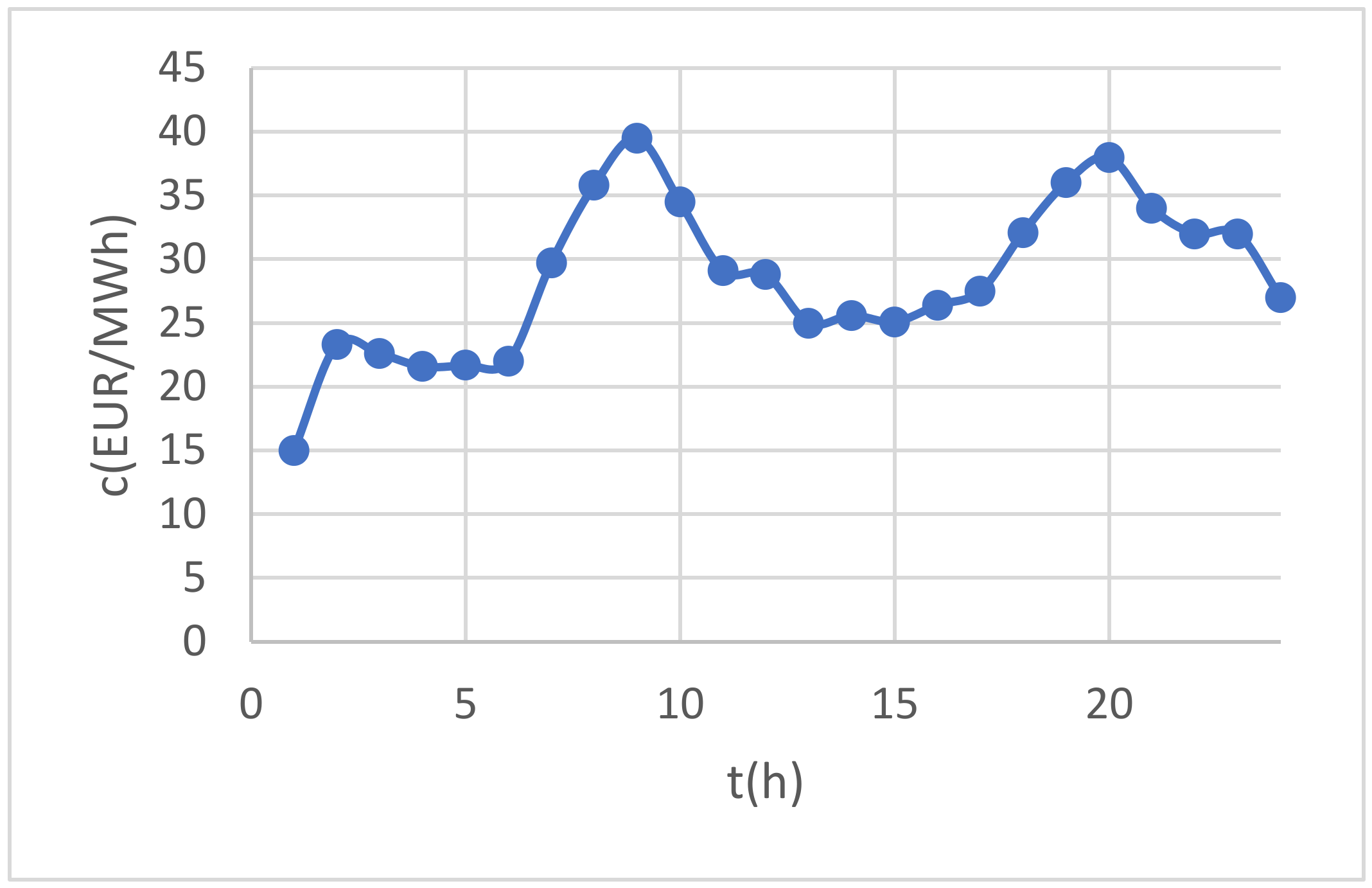
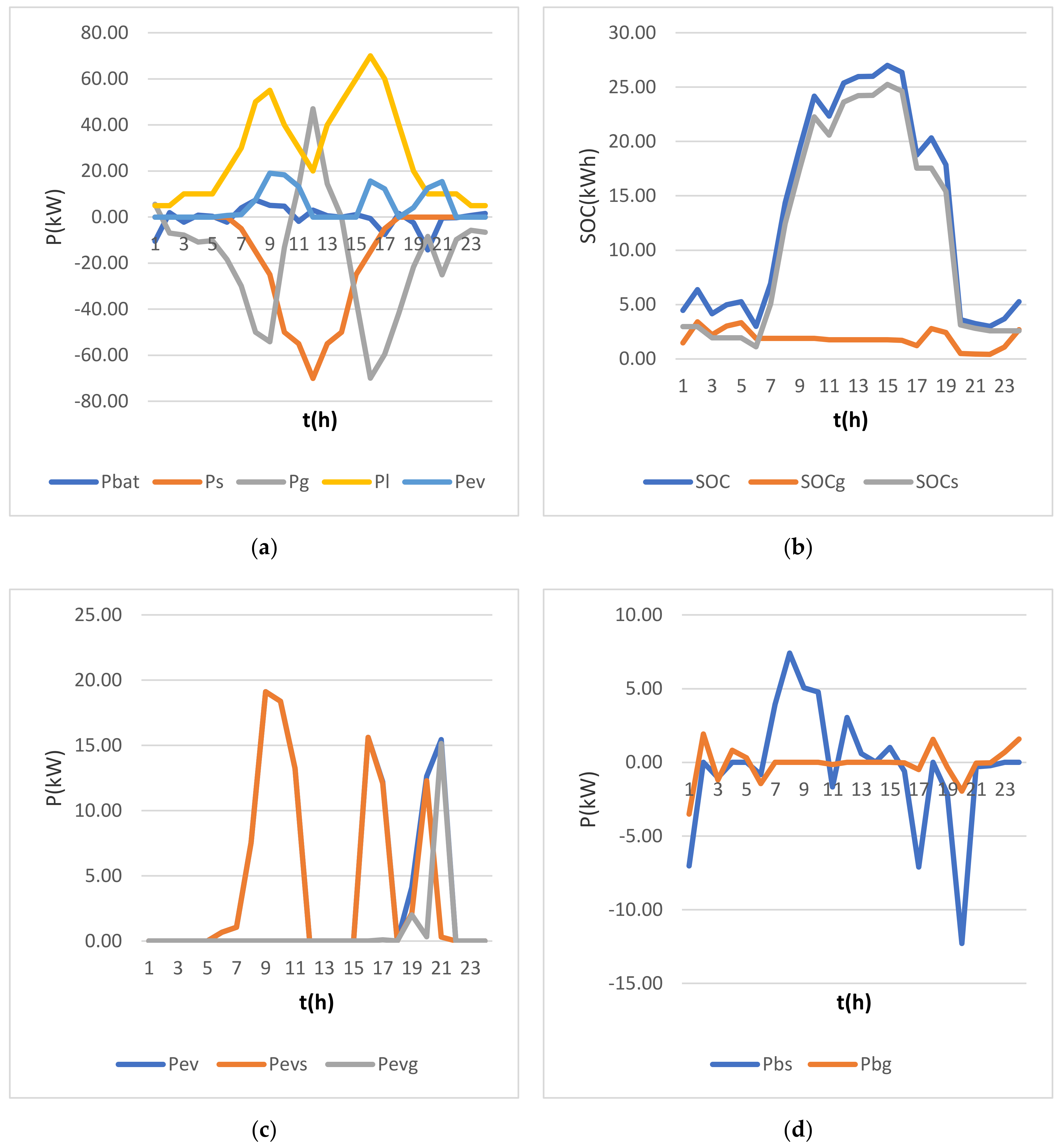
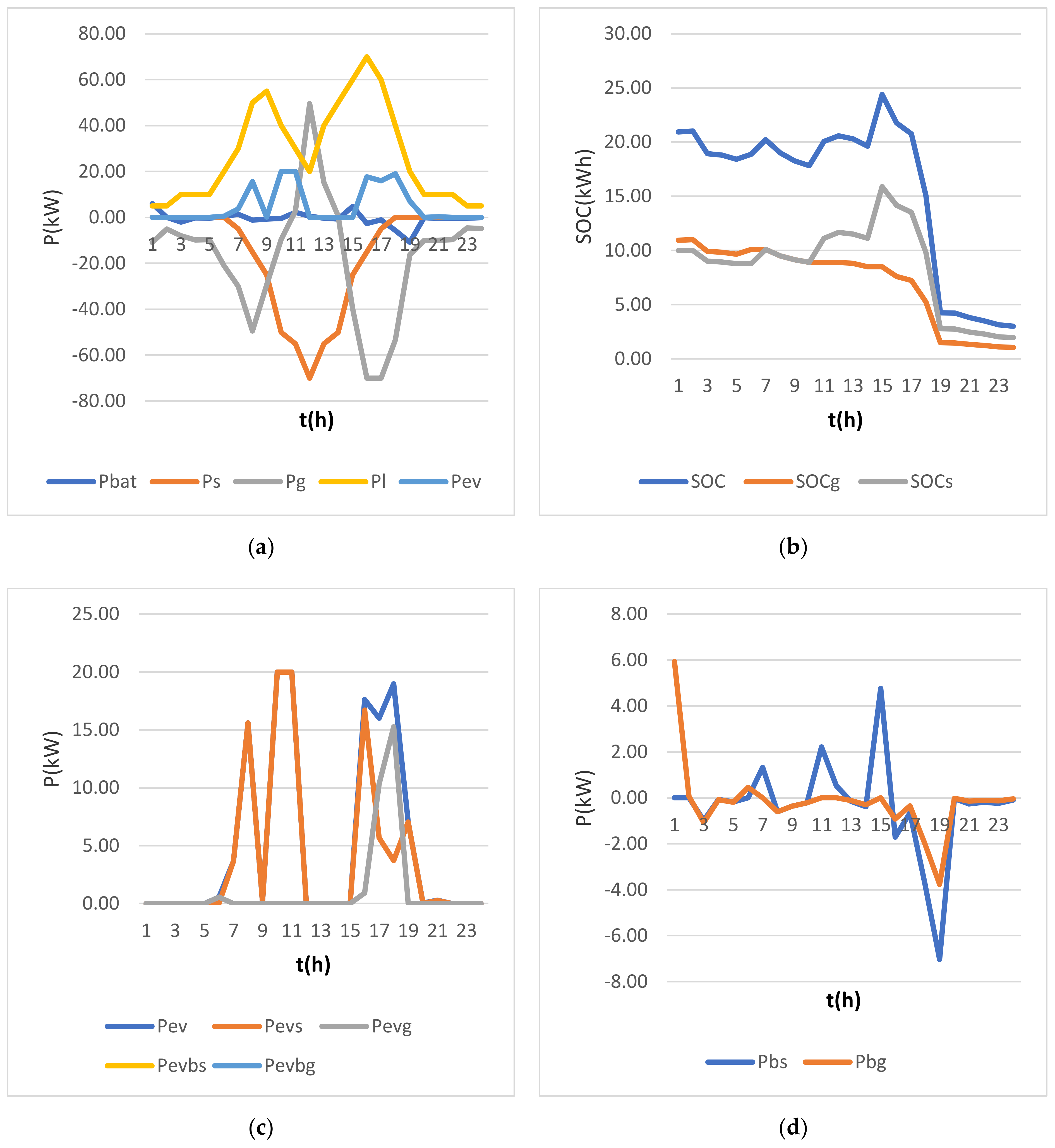
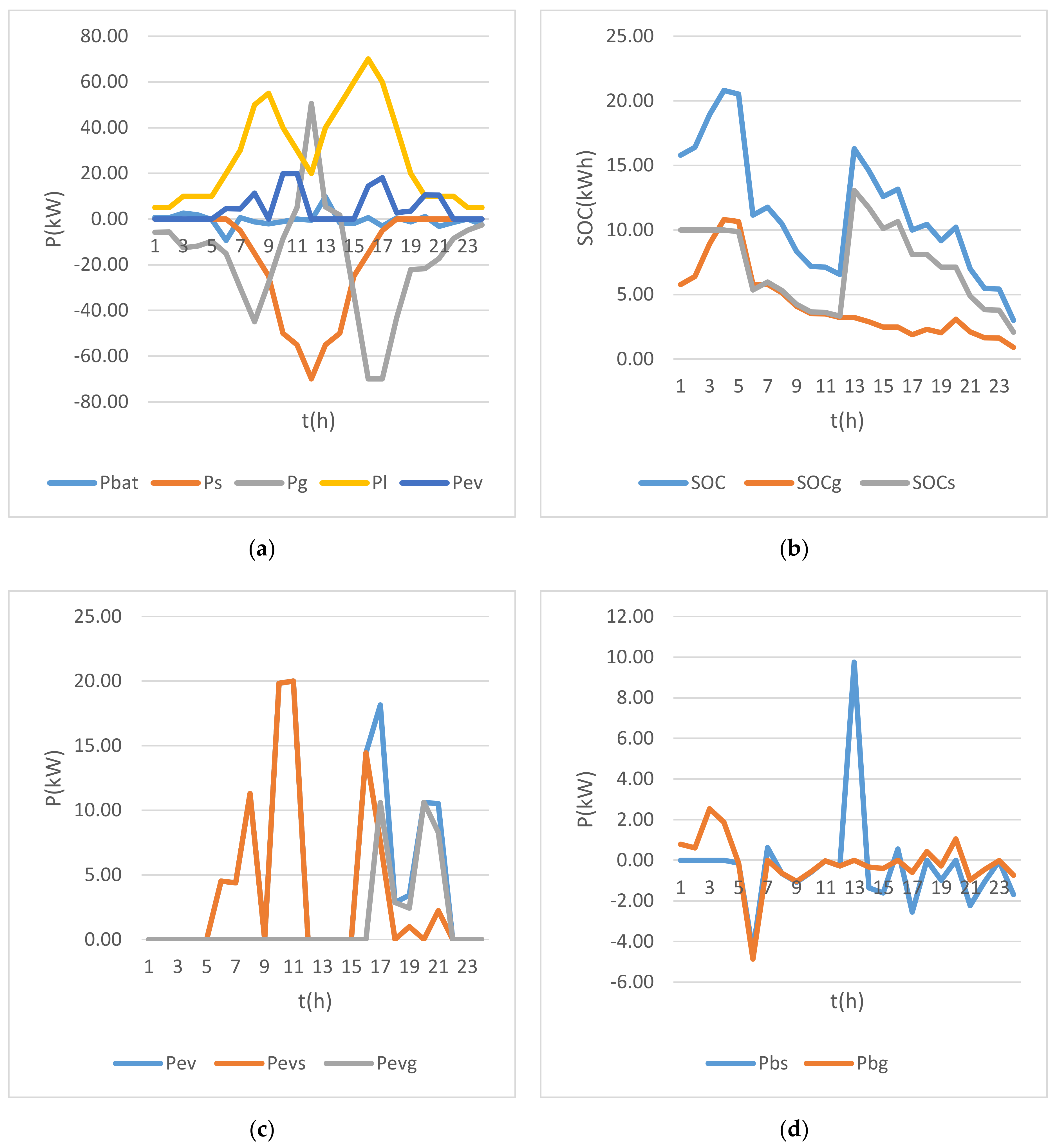


| SOC(0) | 20 kWh | PBmax | 20 kW |
| SOCS(0) | 10 kWh | PEVmax | 20 kW |
| SOCG(0) | 10 kWh | PGmax | 70 kW |
| SOC min | 0.1 C | ηC | 0.9 |
| SOC max | 0.9 C | ηD | 0.9 |
| cB | 0.4 €/(kWh·day) | C | 30 kWh |
| F1 (kWh) | F2 (€) | F3 (%) | |
|---|---|---|---|
| max F1 | 103.91 | 12,518 | 0.69 |
| min F2 | 46.71 | 11,869 | 0.48 |
| min F3 | 63.17 | 12,631 | 0 |
| F1 | U1 | F2 | U2 | F3 | U3 | U | |
|---|---|---|---|---|---|---|---|
| k1 = 0.2 k2 = k3 = 0.3; K = 0.3 | 87.7 (kWh) | 0.59 | 12,209 (€) | 0.52 | 0.69 (%) | 0.80 | 0.57 |
| k1 = k2 = k3 = 0.33; K = 0 | 67.2 (kWh) | 0.34 | 11,963 (€) | 0.53 | 0.41 (%) | 0.88 | 0.62 |
Publisher’s Note: MDPI stays neutral with regard to jurisdictional claims in published maps and institutional affiliations. |
© 2020 by the authors. Licensee MDPI, Basel, Switzerland. This article is an open access article distributed under the terms and conditions of the Creative Commons Attribution (CC BY) license (http://creativecommons.org/licenses/by/4.0/).
Share and Cite
Petrusic, A.; Janjic, A. Renewable Energy Tracking and Optimization in a Hybrid Electric Vehicle Charging Station. Appl. Sci. 2021, 11, 245. https://doi.org/10.3390/app11010245
Petrusic A, Janjic A. Renewable Energy Tracking and Optimization in a Hybrid Electric Vehicle Charging Station. Applied Sciences. 2021; 11(1):245. https://doi.org/10.3390/app11010245
Chicago/Turabian StylePetrusic, Andrija, and Aleksandar Janjic. 2021. "Renewable Energy Tracking and Optimization in a Hybrid Electric Vehicle Charging Station" Applied Sciences 11, no. 1: 245. https://doi.org/10.3390/app11010245





